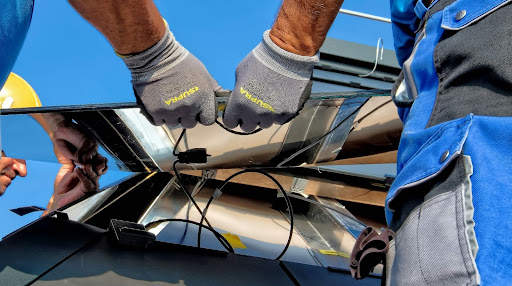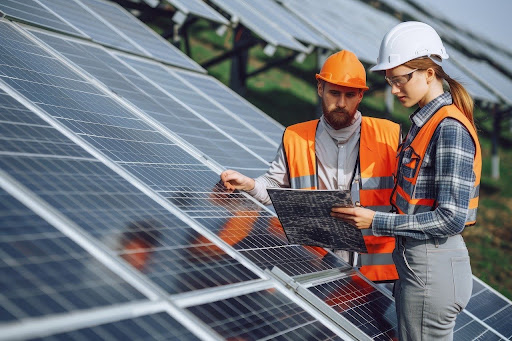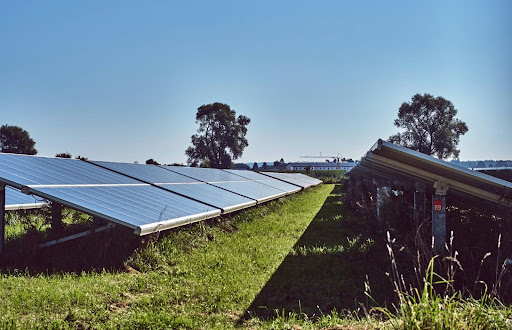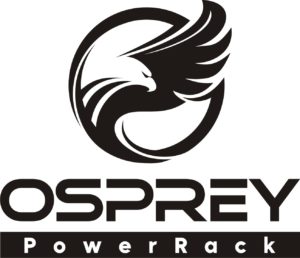Ballasted Ground Mount For Solar: Pros & Cons, Alternatives
Key Takeaways
- Ballasted solar racking systems are ideal for rocky soils and hard surfaces, offering a non-invasive installation method.
- They provide cost efficiency due to reduced labor and equipment needs.
- These systems are limited by space requirements and may not perform well in high-wind areas.
- Alternatives include traditional ground mounts and innovative concrete-free solutions, like Nuance Energy’s Osprey PowerRACK®, which can be installed using only handheld tools.
An Introduction to Ballasted Solar Racking Systems
Ballasted solar racking systems are a type of ground mount that use the weight of the panels themselves to keep them in place. Unlike traditional systems that require drilling into the ground, ballasted systems sit atop the surface, held down by their own mass or additional weights. This makes them particularly suitable for areas where ground penetration is difficult or not allowed.
By eliminating the need for deep anchoring, ballasted systems can be installed quickly and efficiently, reducing both time and labor costs.
During installation, the panels are typically mounted on a pre-fabricated frame that sits on the ground. Weights are then added to the frame to ensure stability. The system can be adjusted to accommodate different angles and orientations, optimizing energy capture based on the site’s specific conditions.
| Nuance Energy is your superior solution for Ground Mount solar. Our patented foundation technology Osprey PowerRACK® allows for rapid installation using only handheld tools, significantly reducing both time and costs compared to traditional racking systems.
This cutting-edge technology works for residential and commercial installations, and Nuance Energy empowers solar installers to take back control of their installation schedules, control project COGS, gain market share, increase the speed of installation, and reduce the cost of labor. In contrast, a traditional ground mount is much more unpredictable, slower, and costly. Find out how Nuance Energy can accelerate your solar projects with the Osprey PowerRACK® line, and boost your profitability. Contact us today to discuss our innovative ground-mount solutions. |
Advantages of Ballasted Solar Racking Systems
Reduced Risk of Leaks
Ballasted solar racking systems significantly reduce the need for roof or ground penetration, lowering the risk of leaks and damage. Traditional systems often require multiple drill points, which can lead to water ingress over time, potentially voiding warranties. With ballasted systems, the risk of structural damage is minimized.
Quick and Easy Installation
The installation process involves placing the pre-fabricated frame on the ground and adding weights to secure it. This simplicity translates to reduced labor requirements and faster project completion times. Unlike traditional systems that may require heavy machinery for digging or drilling, ballasted systems can often be installed with basic tools and a small crew.
Flexibility and Adaptability
Ballasted systems offer flexibility for easy adjustments or relocation – panels can be swiftly repositioned without significant effort.
Enhanced Energy Efficiency
Ballasted systems often feature pre-set tilts that optimize solar panel orientation for maximum sun exposure. The strategic panel angles also reduce shading from nearby panels, ensuring more efficient power generation.
Lower Set-Up Costs
These systems are often more cost-effective due to lower installation costs. The absence of extensive anchoring and minimal material needs reduce labor expenses.

Ballasted solar racking systems have lower installation costs and are at a reduced risk for damage in the long term.
Environmental Benefits
Ballasted systems are environmentally friendly – their installation doesn’t require heavy drilling or excavation, minimizing waste and preserving the integrity of the installation surface. The reduced material use also lowers the overall environmental footprint.
Disadvantages of Ballasted Solar Racking Systems
Wind and Weather Limitations
Ballasted systems are not suitable for areas with extreme weather, particularly high winds, due to reliance on weight rather than ground anchoring. In windy areas, additional ballast or windbreaks may be needed, raising costs and complexity. Additionally, snow accumulation adds weight and heavy rain can cause erosion, potentially affecting stability. Proper site assessment and planning are needed to ensure the longevity and safe use of the system.
Space and Area Requirements
Ballasted solar systems often need more surface area compared to traditional mounts to distribute weight for stability. This can be limiting in space-constrained locations or areas with strict land use regulations. Before choosing a ballasted system, assess your site’s available space and ensure it can accommodate both the panels and ballast.
Weight Considerations
The weight of ballasted systems offers stability without ground anchoring but can pose challenges in transportation and installation, particularly in remote areas. Heavy materials, like concrete blocks, require specialized equipment, increasing logistics complexity.
In some cases, alternative mounting options may be more practical, especially if the location is hard to access or transportation is a concern.

Traditional ground mount systems are anchored into the earth with posts, piles and screws, providing a secure foundation against high winds.
Alternative Ground Mount Options
Traditional Ground Mounts
Traditional ground mounts involve anchoring solar panels directly into the ground using posts, piles, or helical screws. These systems provide a stable and secure foundation – however, they typically require more extensive site preparation and can be more labor-intensive to install.
One of the primary benefits of traditional ground mounts is their ability to withstand high winds and other environmental forces. Because they are anchored into the ground, these systems offer greater stability and durability compared to ballasted systems. However, the installation process is more complex, requiring specialized equipment and skilled labor.
Ballasted Vs. Traditional Ground Mount Systems Comparison Table
| Feature | Ballasted Solar Racking Systems | Traditional Racking Systems |
| Installation Process | Quick installation without drilling; uses weights for stability. | Requires drilling and anchoring, which is time-consuming. |
| Risk of Leaks | Minimal penetration reduces leak risk. | Multiple penetration increases leak potential. |
| Flexibility and Adaptability | Easily movable for maintenance and adjustments. | Generally fixed; moving requires reinstallation. |
| Cost-Effectiveness | Lower initial and long-term costs. | Higher costs from materials, labor, and repairs. |
| Environmental Impact | Eco-friendly; minimizes waste and preserves surfaces. | Can generate waste from drilling; risks roof damage. |

Traditional ground mount systems offer better stability than ballasted systems, but have a more complex installation process.
Geopile Systems
Geopile systems are another alternative to ballasted and traditional ground mounts. These systems use driven piles or screws to anchor the solar panels into the ground. Geopile systems offer a balance between the ease of installation of ballasted systems and the stability of traditional mounts.
Concrete-Free Solutions
For those seeking an environmentally friendly option, concrete-free solutions may be worth considering. These systems use innovative designs and materials to provide a stable foundation without the need for concrete or other invasive anchoring methods.
The Osprey PowerRACK® by Nuance Energy is a minimally invasive alternative to ballasted systems, due to our patented earth anchor technology. By eliminating the need for concrete or pile-driving, the system reduces installation time and material costs, allowing projects to be completed faster and with less specialized labor. Unlike traditional methods that require heavy equipment, the Osprey PowerRACK® can be installed with handheld tools, significantly lowering labor costs and simplifying logistics.
Additionally, the earth anchor system enhances the durability and reliability of solar installations, securing the array to withstand environmental conditions like wind and seismic activity. The anchors are installed with a pull-test to ensure stability, making the system reliable for long-term use on diverse terrains.
Choosing the Right Option
Site Assessment
When planning a solar installation, conducting a thorough site assessment is key – this involves evaluating the physical characteristics of the location, such as soil type, terrain, and available space. For ballasted systems, it’s important to ensure that the ground surface can support the weight of the panels and any additional ballast materials. Consider factors like drainage and potential erosion, which could affect the stability of the installation.
Environmental Conditions
Environmental conditions play a significant role in the performance and longevity of a solar installation. High winds, heavy snow, or frequent rainfall can impact the stability and effectiveness of the system.
Budget Constraints
Ballasted systems can offer cost savings due to their simpler installation process and reduced labor requirements. However, additional costs may arise if extra ballast or stabilization measures are needed – so it’s important to weigh these factors against the potential savings to determine the best option for your project.
Why Choose Nuance Energy’s Osprey PowerRACK® System?
Ballasted solar racking systems provide a cost-effective and non-invasive solution for solar panel installations, especially in areas where ground penetration is difficult. Their ease of installation and minimal environmental impact make them a good choice for many projects. However, certain environmental conditions and space considerations may make them unsuitable for some projects.
Our Osprey PowerRACK® system is a cost-effective alternative to ballasted ground mount systems due to its fast installation and reduced labor demands. Here’s why you should consider it:
- Patented Earth Anchor Technology: The patented earth anchor system ensures stability and durability, even in challenging environmental conditions.
- No Heavy Machinery Required: Handheld tools replace the need for heavy machinery, simplifying the installation process and lowering costs.
- Lower Labor Costs: Lower labor costs are achieved by reducing the need for specialized workers and heavy equipment.
- No Concrete Required: No concrete is required, reducing environmental impact and simplifying the installation process.
- Rapid Deployment: Rapid deployment allows installers to complete projects faster without the delays common in traditional systems.
- Predictable Cost Structure: The system’s predictable cost structure minimizes uncertainties, which is important for more efficient project planning.
- Scalable for Different Project Sizes: The system is scalable, adaptable for both small residential and large utility-scale installations.
- Adaptable to Various Terrains: The system adapts to various terrains, allowing for flexible installations in different project environments.
- Jurisdictional Compliance: Real-time testing and pre-approved reports ensure jurisdictional compliance, facilitating quicker project approvals.
Interested in learning more?
Reach out to us for details about our products and to receive a quote for your next project.
Frequently Asked Questions
What is a ballasted ground mount system?
A ballasted ground mount system is a type of solar racking system that uses weight to secure panels to the ground. Unlike traditional systems that require anchoring into the soil, ballasted systems rely on the mass of the panels and additional weights to provide stability.
Can ballasted systems withstand high wind conditions?
Ballasted systems can be designed to withstand high winds, but it’s important to assess the specific conditions of your site. In areas prone to strong gusts, additional ballast or windbreaks may be necessary to ensure stability. Consulting with a solar engineer will help you determine the appropriate measures for your installation.
Are ballasted systems more expensive than traditional mounts?
Ballasted systems can be more cost-effective than traditional mounts due to their simpler installation process and reduced labor requirements. However, additional costs may arise if extra ballast or stabilization measures are needed to address site-specific conditions.
What are the key benefits of using non-invasive solar mounts?
Non-invasive solar mounts are ideal for sites where ground penetration is not possible or desirable, such as rocky or environmentally sensitive areas. These systems can be installed quickly and with minimal disruption to the surrounding environment, reducing labor costs and project timelines.
Additionally, non-invasive mounts provide flexibility in panel placement and orientation, allowing for optimal energy capture based on site conditions. This can lead to increased energy production and improved return on investment for your solar project.
What are some alternatives to ballasted ground mounts for solar?
Alternatives to ballasted ground mounts for solar include earth anchor systems, driven piles, and helical piers. Innovative systems, like Nuance Energy’s Osprey PowerRACK®, offer a fast installation process without the need for concrete or heavy equipment.
Driven piles are another option, providing stability by driving metal posts deep into the ground. Helical piers, which are screwed into the soil, can be used in areas with soft or uneven terrain. Each option varies in cost, installation time, and suitability for different ground conditions.
Save Time & Money on Your Next Solar Project
Request a QuoteRECENT POSTS
- DPW Solar vs Nuance Energy Mounted Solar Options: Cost & Benefits
- Geotechnical Report Cost & Requirements For Solar Projects
- Are Solar Panels Worth It In Nevada? Costs & Options
- OSPREY PowerRack Ground Mount System Compatibility: Single- and Dual-Axis Trackers
- Rammed Earth Foundation For Solar Arrays: Cost, Pros & Cons
- Agrivoltaics Explained: Solar & Agriculture Combined
- Large Scale Solar Systems Options: Pros & Cons
- Best Solar Options For Farms & Agriculture: Cost, Pros & Cons
- Unirac vs MT Solar Mounted Options: Cost & Benefits
- IronRidge vs Grengy Mounted Solar Options: Cost & Benefits

